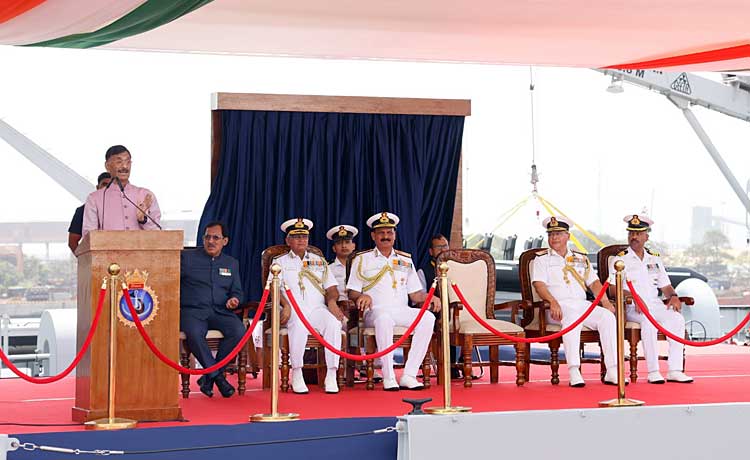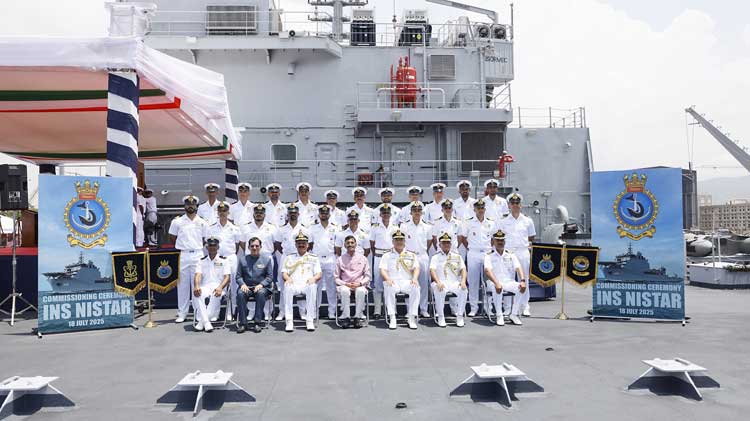INDIAN ARMED FORCES CHIEFS ON OUR RELENTLESS AND FOCUSED PUBLISHING EFFORTS

The insightful articles, inspiring narrations and analytical perspectives presented by the Editorial Team, establish an alluring connect with the reader. My compliments and best wishes to SP Guide Publications.

"Over the past 60 years, the growth of SP Guide Publications has mirrored the rising stature of Indian Navy. Its well-researched and informative magazines on Defence and Aerospace sector have served to shape an educated opinion of our military personnel, policy makers and the public alike. I wish SP's Publication team continued success, fair winds and following seas in all future endeavour!"

Since, its inception in 1964, SP Guide Publications has consistently demonstrated commitment to high-quality journalism in the aerospace and defence sectors, earning a well-deserved reputation as Asia's largest media house in this domain. I wish SP Guide Publications continued success in its pursuit of excellence.
- Global Partners Urged to Tap India's Shipbuilding Potential: Rajnath Singh at Samudra Utkarsh
- All about HAMMER Smart Precision Guided Weapon in India — “BEL-Safran Collaboration”
- India, Germany deepen defence ties as High Defence Committee charts ambitious plan
- G20 Summit: A Sign of Global Fracture
- True strategic autonomy will come only when our code is as indigenous as our hardware: Rajnath Singh
- India–Israel Joint Working Group Meeting on defence cooperation to boost technology sharing and co-development
INS 'Nistar' Commissioned
The Nistar-class project is a series of two diving support vessels to support the Indian Navy's expanding submarine fleet
 |
The Author is Former Director General of Information Systems and A Special Forces Veteran, Indian Army |


INS 'Nistar', the first indigenously designed and constructed Diving Support Vessel, commissioned into the Indian navy at Vizag on July 18, 2025 in the presence of Minister of State (MoS) for Defence Sanjay Seth. The vessel, designed to undertake complex deep sea saturation diving and rescue operations, is built by the Hindustan Shipyard Limited (HSL) in Visakhapatnam. Nistar's sister ship, Nipun, is also expected to be commissioned later this year.
A New Era for Indian Navy's Submarine Rescue Capabilities
In his address, the MoS Defence said commissioning of INS Nistar firmly reinforces the role of the Indian Navy as the 'First Responder' and 'Preferred Security Partner' in the region. The Chief of the Naval Staff Admiral Dinesh K. Tripathi said, "Nistar will provide critical submarine rescue support to the Indian Navy as well as our regional partners. This will enable India to emerge as a 'Preferred Submarine Rescue Partner' in this region."
INS Nistar will provide critical submarine rescue support to the Indian Navy as well as our regional partners. This will enable India to emerge as a 'Preferred Submarine Rescue Partner' in this region.
The Nistar-class project is a series of two diving support vessels to support the Indian Navy's expanding submarine fleet. In December 2017, the HSL won the bid to build two ships for ₹2,019 crore. The Indian Navy signed a contract with the HSL to indigenously design, develop and manufacture these ships on September 20, 2018. Initially, the displacement of the vessel was limited to 7,650 t (7,529 long tonnes) which later was increased to 9,350 t (9,202 long tonnes).

Advanced Technologies and Equipment Onboard the Nistar-class
The ships were fitted with Dynamic Positioning System (DP-II) to automatically maintain its position and heading during underwater operations in harsh conditions. Other equipment also included a six-person Decompression chamber, a Submersible Decompression Chamber (SDC), or Diving Bell, and a Self-Propelled Hyperbaric Lifeboat (SPHL). Diving vessels carried by the ships include two Observation-class Remotely Operated Vehicles (OROVs) and a Deep Submergence Rescue Vehicle (DSRV) along with a helipad with side-scan sonar and 15-tonne subsea crane.
HSL delivered INS Nistar, with an indigenous content of 80 per cent, to the Indian Navy
On May 27, 2024, the newly-built Nistar completed its maiden sea trials, which included assessment of the ship's manoeuvrability, propulsion systems, and onboard equipment. Between March 24 and April 12, 2025, the air/mix gas diving system trial was completed which included unmanned and manned dives at varying depths as well as trials of its Observation-class Remotely Operated Vehicle (OROV). HSL delivered INS Nistar, with an indigenous content of 80 per cent, to the Indian Navy on July 8, 2025. The ship joined Eastern Naval Command on July 18, 2025.

Strategic Role and Regional Impact
These ships, designed to carry a Deep Submarine Rescue Vehicle (DSRV) each, will significantly enhance the Indian Navy's operational and strategic capabilities. They will be capable of rescuing personnel stuck underwater on stricken submarines, a service that will be of use to every country that deploys its submarines in the Indian Ocean region (IOR). These vessels are also Diving Support Vessels (DSVs) that can impart world-class training in deep-sea diving; another capability that can be used for the collective benefit of friendly countries in the IOR.
These ships, designed to carry a Deep Submarine Rescue Vehicle (DSRV) each, will significantly enhance the Indian Navy's operational and strategic capabilities
The Indian Navy procured two Deep Submarine Rescue Vessels (DSRVs) from the UK-based company JFD between 2018 and 2019. At over ten metres in length and a width of over three metres, these twenty-seven-tonne craft resemble mini-submarines. These can be piloted down to 650 metres, mated with the escape hatches of submerged submarines, and slant even up to a steep 60 degrees, rescuing personnel in batches of up to 17. These DSRVs are also supported by a Remote Operating Vehicle (ROV) and a Side Scan Sonar for locating submarines. Although the new DSRVs had been proven at sea and training had been imparted, there were no dedicated ships to carry them. The interim solution involved hiring civilian ships and retaining them at a great cost to ensure assured availability at all times. There was also a need to modernise the Navy's diving training capabilities and enhance the ability to physically observe, carry out repairs, and handle objects at greater depths.
The new INS 'Nistar, as well as INS 'Nipun' to be commissioned later this year, will complete the Indian Navy's the requirements for underwater rescue and training; more so since these vehicles are dedicated for the purpose and stationed one each on the Western and Eastern coast, available for immediate deployment.





